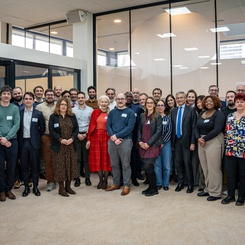From June 9th to June 12th, ESSEC had the privilege of hosting the annual meeting of the Society of Financial Econometrics (SoFiE). The local organizers were a joint team from ESSEC (Andras Fulop, Elise Gourier, Roberto Renò, Jeroen Rombouts, Roméo Tedongap) and CY (Andreas Heinen). Dr. Roberto Renò, an organizer of the event, noted, “I have been fortunate to attend many of these meetings throughout my career in various parts of the world, and I can confidently say that the one held in Cergy was truly excellent.”
.jpg)
Professor Roberto Renò
With 209 registered participants (a record for the meetings), more than 20 scholarships awarded to PhD students and postdocs, and around 100 presentations in total, these four days were a unique experience for ESSEC - and for Cergy as well, with participants taking advantage of scenic views along the Oise.
To provide some background, the Society of Financial Econometrics is a leading institution in the econometrics community, particularly in the area of time series econometrics, since financial data are mostly recorded over time. The Society was created in 2008, when the first meeting was held in Montreal, by Eric Ghysels and Rob Engle. A major inspiration behind the creation of the Society was the Nobel Prize awarded to Rob Engle in 2003, recognizing his pioneering work on financial time series and the creation of a new class of models, the ARCH models, which are the backbone of risk management nowadays. Although the prize was awarded to him individually, as often happens in economics, it was seen as recognition of an entire community. Since then, the community of financial econometricians has grown and reached Cergy. The Society also sponsors an esteemed academic journal, the Journal of Financial Econometrics, of which Professor Renò has just become Co-Editor alongside Brian Kelly (Yale). It supports summer schools around the world, promotes the advancement and sharing of research in financial econometrics, and organizes the annual meeting.
.jpg)
Dr. Robert Engle, Nobel laureate
It was therefore especially meaningful that one of the keynote speakers this year was Dr. Rob Engle himself. Beyond the great honor of welcoming a Nobel Prize winner at ESSEC, his talk stood between academic research (on green portfolios) and public engagement (on climate policy), both of which are central to ESSEC’s mission. Rob presented methods to identify companies’ green strategies and the way markets respond to these strategies through pricing. He compared companies reliant on fossil fuels to a hotel that is guaranteed to close at some unknown future date. How would one manage such a business? This simple metaphor carried deep economic meaning. He also discussed volatility in these distressful days, the role of tariffs, and what policy makers can do to address climate change. Many students attended the lecture in addition to registered participants, and we hope this will provide a lasting impression.
.jpg)
Dr. Robert Engle and Roméo Tédongap, Associate Dean of Faculty at ESSEC
The other keynote speakers were more technical, and equally inspiring. Christian Gourieroux (U Toronto and TSE) gave a compelling presentation on econometric research in neural networks. Anna Mikusheva (MIT) explained how biases in ordinary least squares estimation can arise when the number of explanatory variables increases in time series regressions, and how to correct for this issue. Anders Rahbek (U Copenhagen) presented recent work from his team on models designed to explain the time intervals between financial transactions. The Halbert White Lecture was delivered by Federico Bandi (Johns Hopkins), who introduced a new econometric technique, called signature, and its use in financial applications. On the day before the official opening, Michael Wolf (U Zurich) gave a keynote lecture on shrinkage methods, which are effective for estimating the covariance matrix of asset returns and on which Michael conducted pioneering research for more than a decade. The Presidential Address was delivered by Andrew Patton (Duke), who presented his research on minimum variance portfolios. On the final day, Andrew passed the role of President to the incoming President, Torben Andersen (Northwestern).
.jpg)
In addition to the keynote talks, the conference included 90 presentations and 20 poster sessions, all carefully selected by the program chairs Jean Michel Zakoïan (CREST) and Christian Brownlees (UPF). The scientific quality was exceptional, with presentations on portfolio selection, time series models, high frequency data, market microstructure, asset pricing, risk management, machine learning, and climate finance. A large number of young scholars attended the conference, including many PhD students from ESSEC. The opening day was devoted to research by early career scholars, and the award for best paper was given to Pierluigi Vallarino (Erasmus Rotterdam) for his work on the econometric evaluation of asset pricing models. An event in the Paris region would not be complete without a taste of gastronomy, with a memorable gala dinner, in the 14th arrondissement, featuring a speech given by Kirstin Hubrich, from Deutsche Bundesbank.
Overall, the conference was a memorable experience for the organizing team and for all participants. It reflected ESSEC’s dedication to advanced research and its commitment to renewing and expanding our academic knowledge and networks.
Looking forward to the next meeting, Macao 2026!









